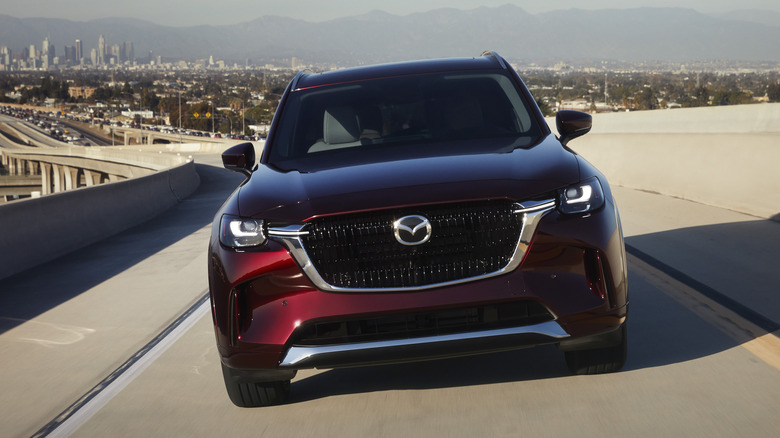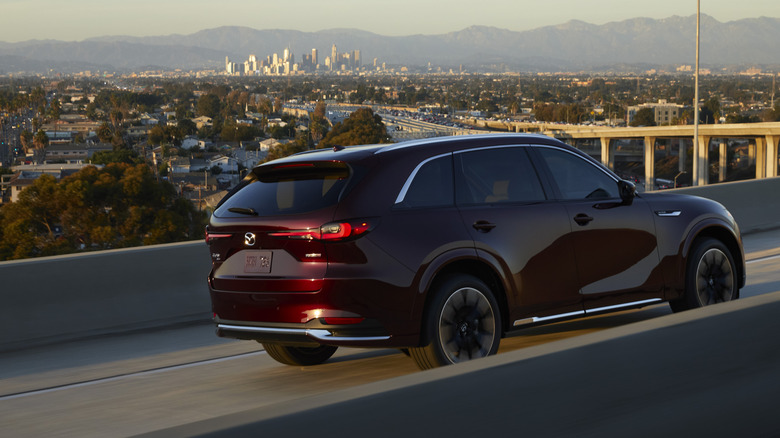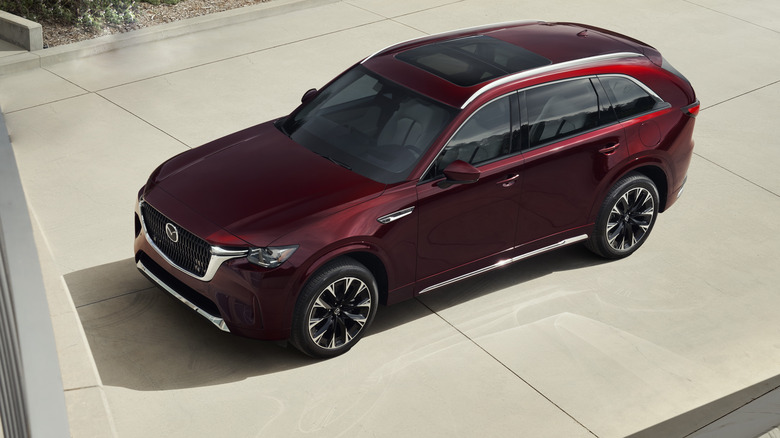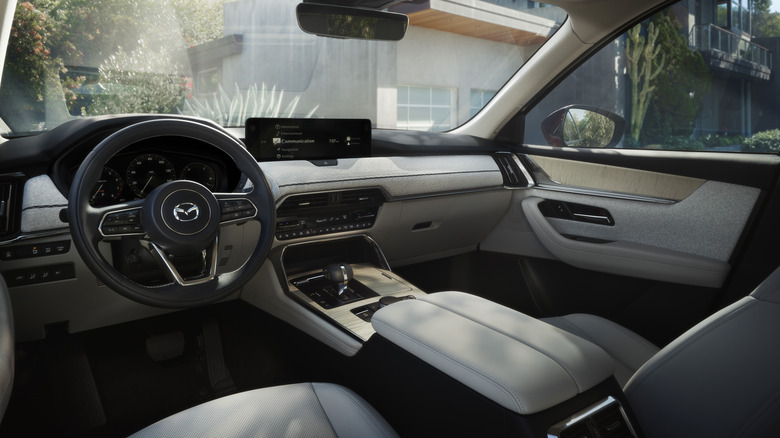The 2023 Mazda CX-9 Vs Mazda CX-90: The Biggest Differences Explained
The Mazda CX-9 is passing the three-row SUV baton to the new 2024 Mazda CX-90, and at first glance, it'd be easy to assume the differences between the two vehicles are slight. Both are, after all, three-row SUVs; both offer all-wheel drive as standard; and both promise that familiar Mazda blend of rewarding driving dynamics and style.
With the CX-9 launched in 2016, however, it's little surprise that Mazda's recipe to achieve all that has changed in the meantime. The family SUV segment is arguably the most competitive in the industry, and while the automaker's current offering is handsome it can't quite hold up to what rivals now offer.
The starting price increases — with the CX-90 line-up kicking off at $39,595 (plus $1,375 destination) in contrast to the CX-9's $38,750 (plus $1,275 destination) — and you'll be able to spec the CX-90 all the way past $60k. In return, you'll get a wider, longer, and more square-jawed design with space for up to eight inside. However, the changes in the 2024 Mazda CX-90 begin to appear where you can't see them.
A new platform means more cabin space
The 2024 CX-90 is the first Mazda to use the automaker's brand new "large platform" with a front-engine, rear-wheel-bias longitudinal layout. It's combined with the Kinematic Posture Control system which Mazda developed for its iconic MX-5 Miata, which promises to cut body lift in tight corners.
Equally important, though, is how that new platform impacts cabin space. It's somewhere the CX-9 was looking increasingly underwhelming in comparison to three-row competitors from Kia, Hyundai, and others, with headroom and legroom in the rearmost row particularly tight.
Third-row headroom is up by 1.5 inches in the CX-90, while both legroom and hip room have also increased. Trunk space also gets a boost: from 14.4 cu-ft in the CX-9 with all seats up, to as much as 15.9 cu-ft in the CX-90. Drop all the seats, and that expands to a maximum of 75.2 cu-ft in the new SUV. That's 4 cu-ft more in the CX-90.
All three drivetrains are electrified
The drivetrain also sees a significant update, and where CX-9 buyers haven't faced a choice with a single-engine option, the CX-90 will have three possibilities to pick from. The base trim is the CX-90 3.3 Turbo, a 48v mild-hybrid 3.3-liter gas engine with 280 horsepower and 332 lb-ft of torque. Mazda expects it to see 24 mpg in the city, 28 mpg on the highway, and 25 mpg combined, making it more economical on the EPA's test cycles than the current CX-9's 2.5-liter turbo engine, despite having more power.
The 2024 CX-90 3.3 Turbo S is also 3.3 liters in capacity and a 48v mild-hybrid, but tuned for more power. It nudges up to 340 horsepower and 369 lb-ft of torque (albeit demanding premium fuel for that, unlike the base turbo engine), with an EPA-estimated 23 mpg city, 28 mpg highway, and 25 mpg combined.
Most interesting is the new CX-90 PHEV. A plug-in hybrid, it combines a 2.5-liter non-turbo gas engine with an electric motor, for a total 323 horsepower and 369 lb-ft of torque (on premium gas). It will be able to drive in a fully-electric mode using power from its 17.8 kWh battery, though EPA economy and range numbers aren't expected until closer to the CX-90 going on sale.
All three engines will be paired with a new, eight-speed transmission. That has two more ratios than the six-speed in the current CX-9, which should help improve refinement as well as economy. All-wheel drive will be standard, but the maximum towing rating — depending on configuration — will increase to 5,000 pounds in the CX-90, versus 3,500 pounds for the CX-9.
More tech in a stylish interior
More space isn't the only thing CX-90 owners are likely to notice about the new SUV's cabin. Though the CX-9 is still surprisingly competitive when it comes to interior design and materials, punching well above its price tag, its technology feels dated in places. That's something Mazda is addressing comprehensively.
Its i-Activsense safety system will be standard across all trims, including Smart City Brake Support, Blind Spot Monitoring, Radar Cruise Control with Stop & Go, Driver Attention Alert, Lane Keep Assist with Lane Departure Warning, and Rear Cross Traffic Alert. Rear seat alerts will also be standard, as will a 10.25-inch infotainment display with Apple CarPlay and Android Auto, plus a 7-inch driver display.
Higher trims will get a Bose audio system, a larger, 12.3-inch infotainment touchscreen, Emergency Lane Keeping, Secondary Collision Reduction System, Blind Spot Assist, and front and rear parking sensors. A 360-degree camera is also available, plus Front Crossing and Turn-Across Traffic Braking.
While this will all help bring the CX-90 in line with what rivals are offering, Mazda does have some new tricks to show off, too. The Mazda Driver Personalization System will use a cabin camera to — optionally — recognize the driver's face and automatically restore their favorite settings.



